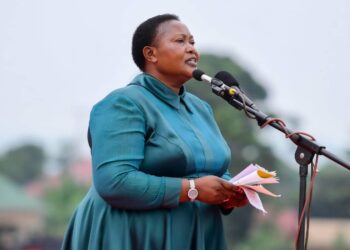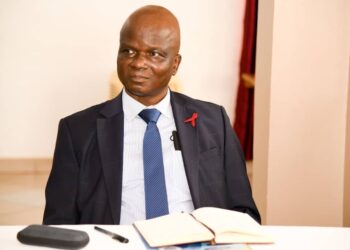Around this time in January of 2017, Bank of Uganda was busy in talks with DFCU bank to ‘buy’ Crane Bank then under statutory management.
Crane Bank had been taken over on October 20 2016 and BoU disposed it off on January 20 2017 to DFCU bank at a give away price. Although the stated price was sh200 billion, many people still believe BoU donated Crane Bank to DFCU, which is today regarded as the worst business deal in Uganda’s recent history!
Crane Bank then valued at more than sh1.2 trillion was offered on Sh200 billion loan, with extra pecks such as buildings to ‘entice’ DFCU.
It is more than three years of this story running in media regularly but with new twists and turns, the latest being an investor in DFCU unable to complete the sale of their shares because of the errors committed in the transaction of Crane bank, a mistake which as been highlighted now and again, but erring officials failed to find a manner to reverse it.
Recently, the Commonwealth Development Corporation (CDC) Group, a British firm owning a stake of 9.97 shares in dfcu Bank, agreed to sale to the Danish Development Finance Institution, the Investment Fund for Development Countries (IFU). These are international bodies that pay attention to detail and respect corporate governance practices.
So, when documents were reviewed, anomalies arose, and one of them is the absence of Bank of Uganda Board minutes regarding the purchase of Crane Bank.
DFCU bank might want to generate the minutes which were clearly indicated in the Parliament probe that they never existed, but they also know the right to do. They need to review the Crane Bank transaction with clear headed people on their and Bank of Uganda side. And agreed to right the wrong of Crane bank. This is going back through the rigorous review of audit of Crane Bank in operation, and offer shareholders their worth and walk away in peace.
Failure to do so, although Bank of Uganda closed down Crane bank in 2016, its ‘ghost’ has refused to leave the corridors of both the seller and buyer.
It has hit Bank of Uganda hard, and this is what is faced by dfcu Ltd, the parent company of dfcu Bank which on December 19, 2019 announced that CDC Group was to sell 74,580,276 shares which make up 9.97 per cent of the total 748, 144,033 ordinary shares in the company. I predicted, more investor will suffer similar problem now and, in the future, if BoU and DFCU bosses continue lying to themselves that all is well, and this wrong is not corrected.
The deal to buy Crane Bank which catapulted DFCU to the second biggest bank in the country, is the Achilles heel, that is preventing it to run as fast as it should for bank of its present size.
Already, DFCU has closed over 20 branches and plans to “lay off half of their staffs” are underway. This comes after dfcu Bank last year asked Bank of Uganda to take back titles for the 48 properties that belong to Meera Investments Ltd of city tycoon Sudhir Ruparelia.
On top of the above, the demands of the Danish Development Finance Institution Danish Company IFU are not helping matters.
Reports indicate that officials close to this matter want to find a way for Parliament’s Committee on Commissions, Statutory Authorities and State Enterprises (COSASE) to revise the earlier report which found the glittering mistakes made by BoU chiefs who sold Crane Bank without minutes nor inventory. But the report has been tabled before the House and the Hansard cannot be edited.
It took the legal world by surprise that MMKAS Advocates who were the transaction advisers acting on behalf of BoU didn’t see this coming. MMKAS were hired by Mrs Justine Bagyenda at Shs 930 million to offer financial advisory services on the closure of Crane bank.
So, when COSASE investigated the controversial sale of the seven commercial banks between 1993 and October 20, 2016 by Bank of Uganda, findings confirmed the fears of the Auditor General who expressed similar complaints earlier in his report. DFCU is walking backwards.
It is clear Bank of Uganda acted in absence of regulations, guidelines and policies in the sale of Crane Bank and that is the wrong which should be corrected. No short cuts.
AG Muwanga noted in his report that,’ in the absence of guidelines and negotiation minutes, I could not determine how BoU selected the best evaluated bidder and how the terms of the P&A were determined’.
So far we know that Bank of Uganda received interest from 13 financial institutions that wanted to buy Crane Bank but only two submitted bids and DFCU was given the green light to buy Crane Bank without negotiation minutes leading to the Purchase & Assumption agreement (P&A).
Verdict
Even if Bank of Uganda could want to help ‘forge’ the minutes, a report in Parliament showing minutes were missing is a large elephant sitting in the way of this deal, because it can cause Parliament to explode.
Yet the people who were instrumental in closing the Crane Bank deal, such as Ms Justine Bagyenda, who was the central bank’s Executive Director for supervision and Dr Louis Kasekende, the deputy governor have since left the Bank in acrimony and therefore cannot be brought back to act on BoU behalf. The same goes to Juma Kisaame, who was the CEO of DFCU and Jimmy Mugerwa who was the board chairman. The duo has since left the commercial bank, which is now stuck and pondering the messed-up future.
BoU and DFCU can exorcise the Crane Bank ghost, by talking to the ghost owners. That is the only out of this mess, and that is if they are interested in getting out the mess.
Do you have a story in your community or an opinion to share with us: Email us at editorial@watchdoguganda.com











